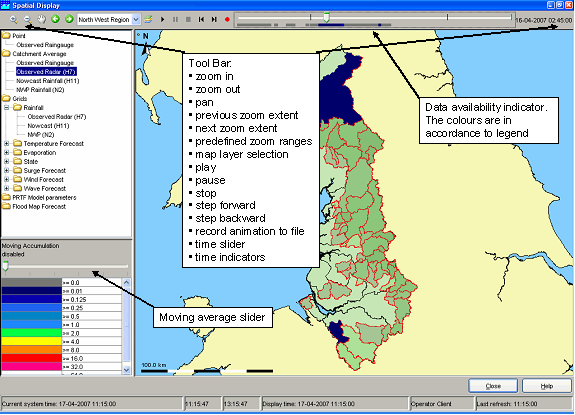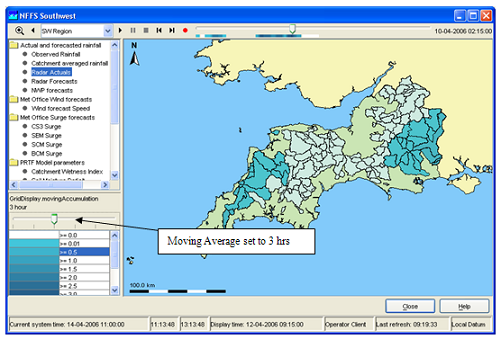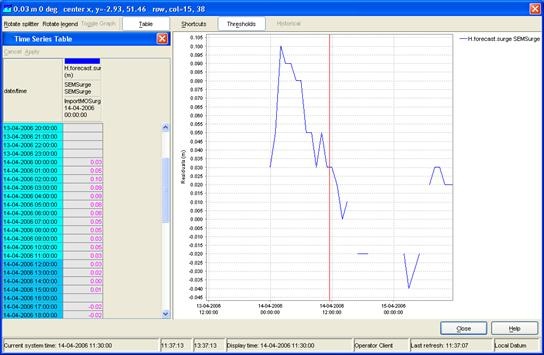| Table of Contents |
|---|
Spatial Display
The Spatial Display grid display can be used to display time series of any type: scalar, polygon or grid. The display will depict the data on a map background. The display time is then set using a ruler that can be moved manually or made to move automatically.
...
- Spatial Display selection filters
- Control Toolbar with following options:
- Manual zoom and zoom previous buttons
- Predefined zoom range selector
- Play, pause, stop, step forward, step backward and record buttons
- Time slider with time slice indicator
- Data availability and maximum value indicator
- Moving average slider
- Legend
- Contours button
- Export time step data in ascii grid-file
Grid display selection filters
The selection filters show which displays have been configured. Select a filter to display the data. Note that each grid display may be configured differently, i.e. with a different period of data to be displayed, with a different background map, etc. The configuration allows filters to be highlighted in bold.
Control Toolbar
The toolbar provides the controls for displaying the spatial information via through the following buttons:
...
For the functionality of the zoom buttons is referred to the FEWS Explorer section (see 2.2).
Moving Average Slider
The moving average slider can be configured to allow the user to select a number of moving average settings. Each moving average window is then recalculated for the entire period.
Legend
The legend identifies the colour used for each range of values. The range of values used for each colour can be rescaled by right clicking on the display and selecting 'Rescale Classification' from the pop-up menu. The display colours will be updated to reflect the new classification. After rescaling, the lowest and highest values in the legend will correspond to the minimum and maximum values of the data in the current zoom extent of the display (for the selected time slice). When the display is zoomed in on an area where all data points or grid cells have similar colours, rescaling can be used to see more clearly the differences in the data values. To return to the default classification right click on the display and select 'Back To Default Classification' from the pop-up menu. When selecting a different plot, the classification always changes back to the default classification for that plot.
The legend can be shown as table legend or as bar legend. Bar legend displays fluent scale bar as shown in the picture below:
Contours button
To turn on/off contour lines (regular grids configured with contour lines only). Numbers appear when the animation has stopped or paused. The colors, which indicate the value remain visible.
Extracting data from the Spatial Display
Export time step data in ascii grid-file
By right clicking on the display, the grid data for a specific timestep can be exported in an ascii file. Select the desirable time step with the control toolbar.
Extracting scalar time series from grid
Scalar time series can be extracted from the grid by double clicking the point of interest. Depending on the type of data, which is displayed, the scalar time series will be relevant to either a point, polygon or grid cell. This can also be done in the following way. First select the point of interest either by right clicking and selecting 'Draw Point' from the pop-up menu or by left clicking. A coloured dot will be drawn to indicate the selected point. For grid data an additional green dot will be drawn to indicate the centre of the selected grid cell. Then extract the time series for the selected point either by right clicking and selecting 'Show Time Series' from the pop-up menu or by pressing the F3 key.
...
Note:
Extraction of scalar time series is not available for rotated pole geodatum types. In some cases extraction of scalar time series can exhibit unexpected behaviour near the North Pole or South Pole.
Extracting longitudinal profiles (Xsections) from a grid time series
Longitudinal profiles time series can be extracted from grid data and shown in a separate graph as well. The profile (or cross section) is defined by drawing a profile sketch. Start drawing a profile sketch either by right clicking and selecting 'Start Drawing Profile' from the pop-up menu or by Ctrl+left clicking on the desired start point for the profile. A coloured dot will be drawn to indicate the selected start point. Add additional line segments to the profile by left clicking in the display. Finish drawing by double-clicking on the desired end point for the profile. Green dots along the profile indicate which grid cells are used for the profile.
...
Note:
If longitudinal profile data is displayed in the spatial display, then there is no need to draw a profile sketch. Just press the F2 key or right click and select 'Show Profile' from the pop-up menu to show the graph of the profile.
Create 2D longitudinal profiles on the fly from data in the Spatial Display
Create a 2D longitudinal profile on the fly for 3D data a in the spatial display. Start drawing a longitudinal profile with a CTRL-click in the spatial display and click to add points as required. Finish the profile with a double-click for the last point. Open up the longitudinal profile in the timeseriesdisplay with CTRL-F11, or via the context menu.
Note, this feature only works for
- data within 1 grid partition. In some cases 3D data model runs are run on multiple domain partitions. This data can be shown as a 2D longitudinal profile, but only if the profile remains within a single domain.
- scalar data (e.g. Water temperature or salinity), and not yet for vector data like currents.
Extracting data for an area from a grid time series (available since build 18645)
For certain types of data it is possible to extract time series data for a specific part of a grid and show this in a separate graph. This is only possible for scalar data with dimension L3/T, L3, L/T, L or 'amount of substance' and for horizontal flow data with dimension L3/T or L/T. The specific part of the grid is defined by drawing an area sketch (a closed polygon surrounding the desired area). Start drawing an area sketch either by right clicking and selecting 'Start Drawing Area' from the pop-up menu or by Shift+left clicking on an edge for the desired area. A coloured dot will be drawn to indicate the selected point. Add additional line segments along the edge of the desired area by left clicking in the display. Finish drawing by double-clicking. The last point in the sketch will be connected to the first point automatically to create a closed polygon that surrounds the desired area. Each grid cell inside the area is marked with a green dot.
...
Note:
The green dots only mark grid cells of which the cell centre is inside the area. The actual calculations also use grid cells that are partially inside the area.
Extracting data for multiple plots at once (available since build 18645)
It is possible to extract data for multiple plots at once. In the selection filters select a folder that contains more than one plot (as direct children). The first plot in the folder will be displayed. Then extract scalar time series, longitudinal profiles or data for an area in the usual way. The extracted data for all the plots in the selected folder will be shown in a combined diagram, where each plot has a separate graph.
Saving and loading sketches from shape files (available since build 18645)
Once a profile sketch or an area sketch has been drawn, the sketch can be saved as a shape file (*.shp file) by right clicking and selecting 'Save Sketch As Shape File'. A saved sketch or any other shape file that represents a profile or an area (a closed polygon) can be loaded into the display by right clicking and selecting 'Load Sketch From Shape File'. The loaded sketch can then be used for extracting data. When loading a sketch, the previous sketch will be erased.
Note:
A shape loaded from file will only be used as an area sketch (a closed polygon) if the first and last points of the shape have exactly the same coordinates. Otherwise the shape will be used as a profile sketch.
Setting the display time
The display time in the spatial display can be changed in the standalone system only . The use is similar to the setting the display time in the data display, but with less modification possibilities.
...





